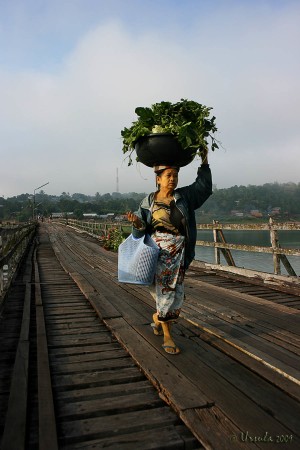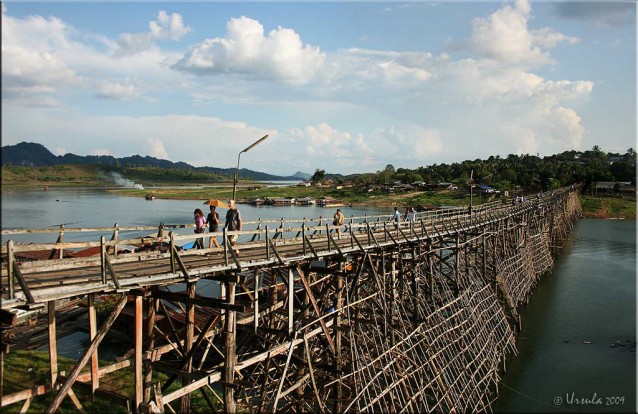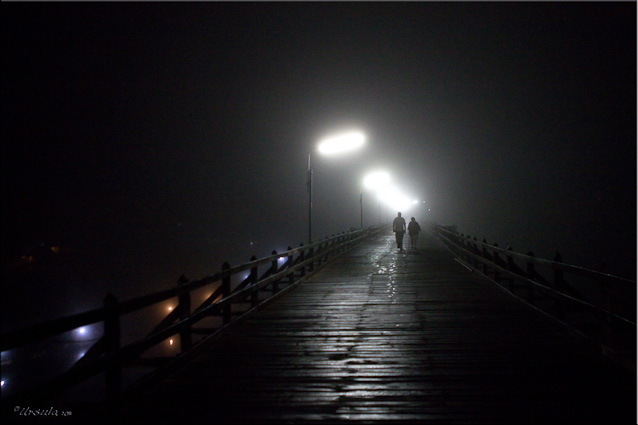 Mon Woman on the Sangkhlaburi Bridge (2009)
Mon Woman on the Sangkhlaburi Bridge (2009)
The other week, someone tried to explain to me how time goes backwards…. (I sometimes lunch with Mathematicians, so this kind of theoretical abstraction is a regular topic at the table.) I confess: I really didn’t get it. As I get older, I swear that time is going faster and I have enough trouble trying to pause it or slow it down!
So, if I don’t understand how time can go backwards, why should I expect that I can travel back through it? If there is one thing I’ve learned living in Thailand, it is that having anything resembling an ‘expectation’ is just asking the universe to throw things at you.
But, none the less, a couple of weeks ago, I thought I could go back in time, and that nothing would have changed. In mid-2009, I took part in a very rushed trip to one of the very edges of Thailand: the exotically named but rather ordinary Three Pagodas Pass, Vajiralongkorn Lake (Khao Laem reservoir), and the remote Ban Wangka, the Mon village across the river from Sangkhlaburi. I’ve always wanted to go back. Sangkhlaburi is an enchanting small town of typical Thai houses and wats (temples) mixed in with guesthouses and back-packer lodging; it is the last stop before Myanmar. It is, however, a very long drive from Bangkok, so you need time (there is that nebulous concept again) and a good reason to go there.

Built in 1993, the longest wooden bridge (400m) in Thailand separates a Mon village from the rest of Sangkhlaburi. (2009)
On the break between Christmas and New Year’s, I thought we had both: time and good reason. We had family visiting from both Canada and Australia, so a visit to the Allied war memorials at Kanchanaburi (more about that some other time) and beyond, seemed like a good idea. I had failed to take “time” into account: the time it takes on winding Thai roads to drive the 200 km from Sai Yok to Sangkhlaburi, and the time that had passed since my last visit.
Change, even change for the better, is considered a stressor. Expectations, realistic or otherwise, can blind one to ‘what is’. So it was, when I arrived in Sangkhlaburi, with (again) too little time, only to discover that they were in the process of renovating THAT bridge, that I almost lost sight of what is still there.
What is still there is a traditional community of Mon people, displaced from Myanmar (not to be confused with Hmong, from China). The community of Ban-Wangka was first established by the Theravada Buddhist monk Reverend Uttama, who escaped to Thailand from Burmese persecution in 1949, after the Second World War. Although he died in 2006, his practices live on. Every morning at 6:00 am the monks from his temple (Wat Wangwiwekaram – วัดวังก์วิเวการาม) do their morning rounds, and the people of the village line up to give alms.

Morning on the New Wooden Bridge (2010)

Monk Offerings: Then (2009)

Monk Offerings: Now (2010)

Slip off your Shoes and Bow your Head: Here Come the Monks!

Who Knew they Could Move so Fast! Here Come the Monks! (2009)

Patiently Waiting

Offerings Ready (2009)

Temple Offerings (2009)

Giving (2009) and Receiving (2010)

Daily Serving of Rice

Giving Alms (Sai Baht ~ ใส่บาตร) is a Solemn Affair without Eye Contact

Monk Receiving Alms (2009)

Monk Receiving Alms ~ Now

Some Things Don't Change! Little Nehn (เณร) ~ Then and Now

By 7:00am the gong sounds, setting all the dogs howling pitifully, and the food is dished up for all the monks in the temple. The rest of the villagers go back to their daily routines...

Monks Heading Home

Little Angel with Flower Offerings

Quiet Afternoon: The Mon Houses of Baan Wangka

Boys on the Bridge: What does the Future Hold?
While theoretical time might reverse, here on planet earth you can never quite go back. For better or worse, things change, times change, we change. I looked at the young men sitting on the bridge and wondered what time would hold for them. How would they bridge the transition from a simple traditional past and the future?

I guess only time will tell, but I can’t help but hope that somehow these people will determine a positive future for themselves, harmoniously incorporating the values of the past. Certainly, time will not stand still.
Not for any of us.



.jpg)


Just lovely Ursula, nice touch with the before and after photo’s. Time moves so quickly I have to agree… January is half gone, where is the new year going…
love to you both
Thanks, Signe! Stay well. 🙂
beautiful linkage 🙂
Some great portrait shots Ursula!